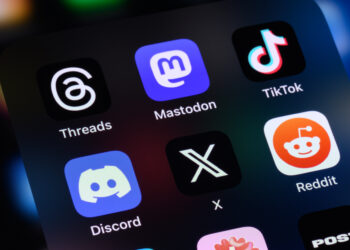
- Image via Wikipedia
On Monday, Steve Jobs unveiled the fourth generation iPhone and the latest iteration of Apple’s iPhone/iPad/iPod Touch OS, now dubbed “iOS4”. While there were no major surprises, and the actual form factor of the device had already been revealed through some ethically questionable (and possibly illegal) practices at Gizmodo, it’s a welcome set of upgrades, and an aesthetically pleasing new design, one which Jobs referred to as reminding him of “a classic Leica camera.”
While you can get a full rundown of all the new features at sites like Ars Technica, publishers should pay particular attention to a few key points, most revolving around iBooks and the iBookstore.
The first big bombshell was Jobs’ claim that in its first 65 days, the iBookstore has captured 22% of the eBook market. As with all Jobs keynote statistics, one has to wait for clarification of exactly what this figure means, but it appears to come from reports from publishers selling in the iBookstore — that of their e-book sales, 22% now come from Apple, which claims around 5 million e-books sold. The iBookstore works only on the iPad, and these don’t sound like outrageous numbers with 2 million iPads on the market. Compare that number to the estimated number of Kindle devices in the wild (around 2 to 3 million), and it’s not surprising to see Apple rapidly catching up.
The big question, then, is, What happens to the market when Apple’s iOS4 is released in the near future?
The iBookstore’s installed base will then jump from 2 million to 100 million devices.
Will this mean a massive jump in Apple’s share of the e-book market? It’s hard to say. Each of those 100 million devices can also run the Kindle app, along with apps from Barnes and Noble and other e-book sellers. Apple may have a big advantage over other sellers though, because readers can buy new books from within the iBooks app itself. Kindle app users have to leave the app, visit Amazon via the Safari web browser, and make their purchases there. Don’t underestimate the importance of this. The power of in-app purchasing is evident from the music download market, where Apple holds a 70% share. Amazon, which usually offers better prices on mp3 downloads, has only 12% of the market. Clearly price is not a differentiator in this market, but convenience is. Will those extra purchasing steps be as difficult to overcome in the e-book market as well?
Much of the Kindle’s support comes from the quality of its display of text. Many prefer reading on the device to Apple’s backlit, lower resolution screen. The new iPhone will still be backlit, but it will be interesting to see how the reading experience changes with Apple’s new Retina Display technology, which purports to give the device a pixel density at the highest level the human retina can detect, essentially giving the same resolution as the printed page. How long will it take Apple to migrate this technology to the iPad? Will this negate the Kindle’s advantage?
Finally, Apple announced the addition of a PDF reader to its iBooks app. The new version will allow the user to annotate and bookmark within PDFs and sync them between devices.
Details are scarce about the interface for the annotations and exactly how one would view them on a non-iPad/iPhone/iPod device. Direct note-taking on PDFs has yet to find an elegant solution, which is probably why so many scholarly journal readers print out their articles, so they can scribble in the margins with a pen. If Apple has applied their customary interface design quality here, it could be greatly beneficial in pushing our readers further away from paper and closer to being comfortable with reading on screens. This would be a welcome development as so many of the new data display technologies creeping into scholarly journals require online/onscreen viewing. While the PDF is still something of an archaic and limited file format, any step away from print is a move forward.
Apple’s implementation of syncing, sharing, and viewing these annotated PDFs may also have serious implications for both makers of annotation apps, and for companies building suites of collaboration tools for researchers. If the ability to annotate papers is built into the device itself, it’s one less reason to bother with an outside service.
More to follow on this once we get some concrete details.
Discussion
5 Thoughts on "Apple’s iPhone 4 and iOS4: What Do They Mean for Publishers?"
One of my concerns as both a publisher and an iPad owner is something that Jobs ignores with his convoluted 22% of the market statistic, and that is selection. Sure those publishers are seeing a huge jump in how many iBooks their selling compared to those same titles as Kindle editions, but I suspect that’s more a function of how little there is to choose from and how many devices are out there. Apple’s only offering 60,000 titles, but Amazon offers over 200,000. I’m not finding a hell of a lot I want to read at the iBookstore. And Apple isn’t exactly making it easy for publishers to get their content on the platform. If they’re serious about this iBook thing, they need to rethink how they’re relating to publishers. Otherwise, very soon, a rainbow logo-ed behemoth is going to open their platform up and they’re likely to drink Apple’s milkshake.
That may be changing in the near future. We’re a small publishing house and have just received approval from Apple for our products in the iBookstore. I haven’t yet had time to read their terms of service and we haven’t yet accepted, but it looks like Apple is working to expand their content. More details on applying can be found here.
Hi!
First off: I cofounded letsannotate.com which you mentioned above.
You said that Apple’s implementation of syncing, sharing, and viewing annotated PDFs may have serious implications for makers of annotation apps.
Generally I agree with you, apps that provide exactly the same functionality as iBooks will have a hard time.
But IMHO Apple simply doesn’t get the Web. iBooks annotations can only be synced through iTunes and can’t be shared with other users.
letsannotate.com enables real time annotating with multiple users and – I believe – therefore solves a completely different problem.
I agree that Apple has screwed the pooch as far as their cloud strategy. MobileMe had a rocky start and remains something of a mess. I do get the feeling though that if Google’s cloud-based strategies start to catch on, Apple will finally focus on making it more worthwhile.
And as you note, the way to stay afloat is to do something better, offer the user more.
![Reblog this post [with Zemanta]](http://img.zemanta.com/reblog_e.png?x-id=33c86e2d-4c08-4f24-aabd-8437d23d4a82)


